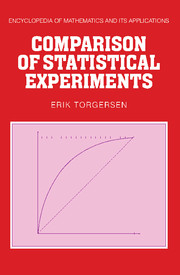Book contents
- Frontmatter
- Contents
- Preface
- Acknowledgments
- 1 Statistical experiments within the measure theoretical framework
- 2 Convexity
- 3 Two-person, zero-sum games
- 4 Statistical decision problems
- 5 Vector lattices
- 6 Deficiencies
- 7 Equivalence, representations and functionals of experiments
- 8 Comparison of linear models
- 9 Majorization and approximate majorization
- 10 Complements: Further examples, problems and comments
- List of symbols
- Author index
- Additional references
- Subject index
8 - Comparison of linear models
Published online by Cambridge University Press: 05 May 2013
- Frontmatter
- Contents
- Preface
- Acknowledgments
- 1 Statistical experiments within the measure theoretical framework
- 2 Convexity
- 3 Two-person, zero-sum games
- 4 Statistical decision problems
- 5 Vector lattices
- 6 Deficiencies
- 7 Equivalence, representations and functionals of experiments
- 8 Comparison of linear models
- 9 Majorization and approximate majorization
- 10 Complements: Further examples, problems and comments
- List of symbols
- Author index
- Additional references
- Subject index
Summary
Introduction
In this chapter we will consider comparison of some of the most familiar linear models. Here ‘linear’ means essentially that the expectations of the observations depend linearly on the unknown parameter. The main emphasis will be on linear models with covariances which are either completely known or are known up to a common positive factor. The observations which realize our models may not be normally distributed. However, if we assume they are normally distributed, the conclusions may be drastically strengthened. In this case the Hellinger transform is a very useful tool.
As we do not wish to stretch the generality too far, we shall restrict our attention to models where the dimensions of the parameter spaces and the sample spaces are finite. We shall find it convenient to use a coordinate-free approach and we shall assume that the underlying spaces are finite dimensional inner product spaces, i.e. finite dimensional Hilbert spaces.
One advantage of using this framework rather than the ℝn-approach is that the various related linear spaces need not be re-parametrized in order to be in the appropriate form. This framework also appears to make it easier to envisage generalizations to infinite dimensional spaces.
Before proceeding we should state some basic facts on random vectors. Firstly a finite dimensional inner product space, as any metric space, has a natural topology. The Borel class is of course the σ-algebra generated by the open sets (closed sets, compact sets) and this is the smallest σ-algebra making the linear functional measurable. Representing the vectors by their coordinates with respect to a fixed orthonormal basis we obtain an isomorphism between H and some space ℝm equipped with the usual scalar product.
Information
- Type
- Chapter
- Information
- Comparison of Statistical Experiments , pp. 411 - 504Publisher: Cambridge University PressPrint publication year: 1991
Accessibility standard: Unknown
- 1
- Cited by
